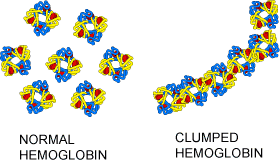
How is sickle cell disease treated?

What tests are used to diagnose sickle cell disease?
The test used to diagnose sickle cell disease is a simple blood test. The blood test can detect if a person has sickle hemoglobin. In the United States, all states have made it mandatory to test newborns. This can help to diagnose if a newborn baby has sickle hemoglobin. If a test shows trace amounts of sickle hemoglobin a second blood test is ordered to confirm the diagnosis of sickle hemoglobin. Usually, a doctor will send you to a hematologist. A hematologist is a doctor who specializes in blood diseases and disorders. If needed, the hematologist can provide the treatment needed for sickle cell disease. Lastly, doctors can also diagnose sickle cell disease before birth even occurs. In order for doctors to diagnose a still not yet born baby, they take a sample of amniotic fluid or tissue from the placenta. This test can be done as early as 10 weeks into the pregnancy. This test is used to look for the sickle hemoglobin gene.
Treatments for sickle cell disease include; antibiotics, pain relieving medications, and hydroxyurea. Children who have sickle cell anemia may begin to take penicillin when they’re about two months old. Children will continue to take penicillin until they are five years of age. This helps to prevent life threatening infections to an infant or child that has inherited sickle cell anemia. Pain-relieving medications help to relieve pain during a crisis. If crises worsen a doctor might prescribe other over-the-counter pain relievers and may tell him or her to apply heat to the affected area.
Hydroxyurea reduces the frequency of crises and may also help to reduce the need for a blood transfusion. Hydroxyurea works by stimulating the production of fetal hemoglobin. This medication however, increases the risk of infections that can worsen to tumors or leukemia. Immunizations also help to prevent infections in people who have sickle cell anemia. This is because those who have sickle cell anemia tend to become sick more often. To add on, a blood transfusion is another way to help treat sickle cell disease. In a red blood cell transfusion, red blood cells are removed from donated blood. The donated blood is then given to a person who is diagnosed with sickle cell anemia. Blood transfusions help to increase the number of normal red blood cells that are in circulation. This helps to relieve anemia.
If a person is at high risk of stroke due to the sickle cell anemia, a regular blood transfusion can help to decrease the risk of stroke. Blood transfusions carry many risks. Regular blood transfusions can cause excess amount of iron build up in a person’s body. Excess iron can damage the liver, heart, and other important organs.
Lastly, to treat sickle cell anemia, a stem transplant, or bone marrow transplant may be necessary. This transplant replaces bone marrow affected by sickle cell anemia with healthy bone marrow from a doctor. A stem cell transplant is recommended for people who only have significant symptoms and complications with sickle cell anemia. If a person has a donor, the diseased bone marrow is depleted with radiation or chemotherapy. The stem cell that is healthy, are injected into the bloodstream of the sickle cell anemia patient. They then migrate to the cavities of the bone marrow and begin to generate new red blood cells.
After treatment, the patient will receive drugs to help prevent rejection of the stem cell that was donated. There is a chance that the patient’s body may reject the transplant, which can lead to life-threatening complications. Also, not every single patient can find a donor or is a candidate for a transplant. New treatments scientists are studying to treat sickle cell anemia include gene therapy, nitric oxide, and drugs to boost fetal hemoglobin production.
There are many new prognoses for sickle cell disease. In 1973, the average lifespan for a person who has sickle cell disease was only approximately fourteen years old. Today, however; the life expectancy for patients can reach up to 50 years, and possibly more. Studies show that women with sickle cell disease tend to live longer than males. The damage of sickle cell disease occurs because of the logjam that sickle cells cause in the capillaries. The disease slows the flow of blood and reduces the supply of oxygen to various tissues. Pain occurs when body tissues are damaged by the lack of oxygen but also can lead to serious life-threatening problems. These problems can result from prolonged oxygen deprivation. In children, signs of impaired lung function may occur in early stages of life. The serious dangers that may occur are acute chest syndrome, stroke, and complications during pregnancy, and long-term damage to major organs.
What are the prognoses for sickle cell disease?
Below is a game where you can help determine if a patient has sickle cell disease.
References
Can fifth disease be harmful to my toddler?. (2014). Retrieved from https://www.healthtap.com/user_questions/12019-can-fifth-disease-be-harmful-to-my-toddler
SCD. (n.d.). SCD. Retrieved April 28, 2014, from http://www.nature.com/pr/journal/v75/n1-
Sickle Cell DNA. (n.d.). Edheads -. Retrieved April 28, 2014, from http://edheads.org/activities/dna/
